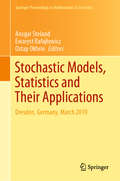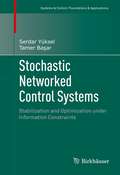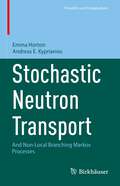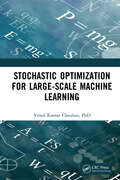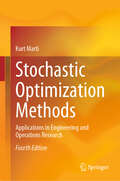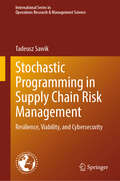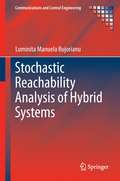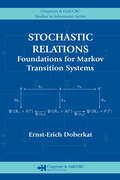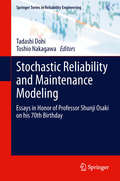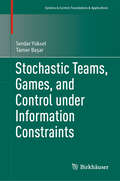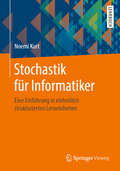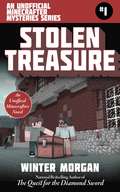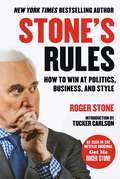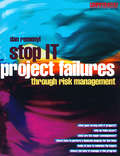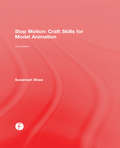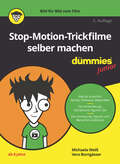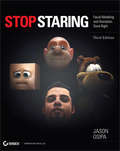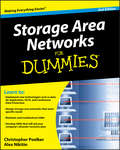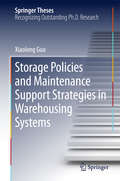- Table View
- List View
Stochastic Models, Statistics and Their Applications: Dresden, Germany, March 2019 (Springer Proceedings in Mathematics & Statistics #294)
by Ansgar Steland Ewaryst Rafajłowicz Ostap OkhrinThis volume presents selected and peer-reviewed contributions from the 14th Workshop on Stochastic Models, Statistics and Their Applications, held in Dresden, Germany, on March 6-8, 2019. Addressing the needs of theoretical and applied researchers alike, the contributions provide an overview of the latest advances and trends in the areas of mathematical statistics and applied probability, and their applications to high-dimensional statistics, econometrics and time series analysis, statistics for stochastic processes, statistical machine learning, big data and data science, random matrix theory, quality control, change-point analysis and detection, finance, copulas, survival analysis and reliability, sequential experiments, empirical processes, and microsimulations. As the book demonstrates, stochastic models and related statistical procedures and algorithms are essential to more comprehensively understanding and solving present-day problems arising in e.g. the natural sciences, machine learning, data science, engineering, image analysis, genetics, econometrics and finance.
Stochastic Networked Control Systems
by Tamer Başar Serdar YükselNetworked control systems are increasingly ubiquitous today, with applications ranging from vehicle communication and adaptive power grids to space exploration and economics. The optimal design of such systems presents major challenges, requiring tools from various disciplines within applied mathematics such as decentralized control, stochastic control, information theory, and quantization. A thorough, self-contained book, Stochastic Networked Control Systems: Stabilization and Optimization under Information Constraints aims to connect these diverse disciplines with precision and rigor, while conveying design guidelines to controller architects. Unique in the literature, it lays a comprehensive theoretical foundation for the study of networked control systems, and introduces an array of concrete tools for work in the field. Salient features included: · Characterization, comparison and optimal design of information structures in static and dynamic teams. Operational, structural and topological properties of information structures in optimal decision making, with a systematic program for generating optimal encoding and control policies. The notion of signaling, and its utilization in stabilization and optimization of decentralized control systems. · Presentation of mathematical methods for stochastic stability of networked control systems using random-time, state-dependent drift conditions and martingale methods. · Characterization and study of information channels leading to various forms of stochastic stability such as stationarity, ergodicity, and quadratic stability; and connections with information and quantization theories. Analysis of various classes of centralized and decentralized control systems. · Jointly optimal design of encoding and control policies over various information channels and under general optimization criteria, including a detailed coverage of linear-quadratic-Gaussian models. · Decentralized agreement and dynamic optimization under information constraints. This monograph is geared toward a broad audience of academic and industrial researchers interested in control theory, information theory, optimization, economics, and applied mathematics. It could likewise serve as a supplemental graduate text. The reader is expected to have some familiarity with linear systems, stochastic processes, and Markov chains, but the necessary background can also be acquired in part through the four appendices included at the end. · Characterization, comparison and optimal design of information structures in static and dynamic teams. Operational, structural and topological properties of information structures in optimal decision making, with a systematic program for generating optimal encoding and control policies. The notion of signaling, and its utilization in stabilization and optimization of decentralized control systems. · Presentation of mathematical methods for stochastic stability of networked control systems using random-time, state-dependent drift conditions and martingale methods. · Characterization and study of information channels leading to various forms of stochastic stability such as stationarity, ergodicity, and quadratic stability; and connections with information and quantization theories. Analysis of various classes of centralized and decentralized control systems. · Jointly optimal design of encoding and control policies over various information channels and under general optimization criteria, including a detailed coverage of linear-quadratic-Gaussian models. · Decentralized agreement and dynamic optimization under information constraints. This monograph is geared toward a broad audience of academic and industrial researchers interested in control theory, information theory, optimization, economics, and applied mathematics. It could likewise serve as a supplemental graduate text. The reader is expected to have some familiarity with linear systems, stochastic processes, and Markov chai...
Stochastic Neutron Transport: And Non-Local Branching Markov Processes (Probability and Its Applications)
by Emma Horton Andreas E. KyprianouThis monograph highlights the connection between the theory of neutron transport and the theory of non-local branching processes. By detailing this frequently overlooked relationship, the authors provide readers an entry point into several active areas, particularly applications related to general radiation transport. Cutting-edge research published in recent years is collected here for convenient reference. Organized into two parts, the first offers a modern perspective on the relationship between the neutron branching process (NBP) and the neutron transport equation (NTE), as well as some of the core results concerning the growth and spread of mass of the NBP. The second part generalizes some of the theory put forward in the first, offering proofs in a broader context in order to show why NBPs are as malleable as they appear to be. Stochastic Neutron Transport will be a valuable resource for probabilists, and may also be of interest to numerical analysts and engineers in the field of nuclear research.
Stochastic Optimization for Large-scale Machine Learning
by Vinod Kumar ChauhanAdvancements in the technology and availability of data sources have led to the `Big Data' era. Working with large data offers the potential to uncover more fine-grained patterns and take timely and accurate decisions, but it also creates a lot of challenges such as slow training and scalability of machine learning models. One of the major challenges in machine learning is to develop efficient and scalable learning algorithms, i.e., optimization techniques to solve large scale learning problems. Stochastic Optimization for Large-scale Machine Learning identifies different areas of improvement and recent research directions to tackle the challenge. Developed optimisation techniques are also explored to improve machine learning algorithms based on data access and on first and second order optimisation methods. Key Features: Bridges machine learning and Optimisation. Bridges theory and practice in machine learning. Identifies key research areas and recent research directions to solve large-scale machine learning problems. Develops optimisation techniques to improve machine learning algorithms for big data problems. The book will be a valuable reference to practitioners and researchers as well as students in the field of machine learning.
Stochastic Optimization Methods: Applications in Engineering and Operations Research
by Kurt MartiThis book examines optimization problems that in practice involve random model parameters. It outlines the computation of robust optimal solutions, i.e., optimal solutions that are insensitive to random parameter variations, where appropriate deterministic substitute problems are needed. Based on the probability distribution of the random data and using decision theoretical concepts, optimization problems under stochastic uncertainty are converted into corresponding deterministic problems.Due to the probabilities and expectations involved, the book also shows how to apply approximative solution techniques. Several deterministic and stochastic approximation methods are provided: Taylor expansion methods, regression and response surface methods (RSM), probability inequalities, multiple linearization of survival/failure domains, discretization methods, convex approximation/deterministic descent directions/efficient points, stochastic approximation and gradient procedures, and differentiation formulas for probabilities and expectations.The fourth edition of this classic text has been carefully and thoroughly revised. It includes new chapters on the solution of stochastic linear programs by discretization of the underlying probability distribution, and on solving deterministic optimization problems by means of controlled random search methods and multiple random search procedures. It also presents a new application of stochastic optimization methods to machine learning problems with different loss functions. For the computation of optimal feedback controls under stochastic uncertainty, besides the open-loop feedback procedures, a new method based on Taylor expansions with respect to the gain parameters is presented. The book is intended for researchers and graduate students who are interested in stochastics, stochastic optimization, and control. It will also benefit professionals and practitioners whose work involves technical, economicand/or operations research problems under stochastic uncertainty.
Stochastic Programming in Supply Chain Risk Management: Resilience, Viability, and Cybersecurity (International Series in Operations Research & Management Science #359)
by Tadeusz SawikThis book offers a novel multi-portfolio approach and stochastic programming formulations for modeling and solving contemporary supply chain risk management problems. The focus of the book is on supply chain resilience under propagated disruptions, supply chain viability under severe crises, and supply chain cybersecurity under direct and indirect cyber risks. The content is illustrated with numerous computational examples, some of which are modeled on real-world supply chains subject to severe multi-regional or global crises, such as pandemics. In the computational examples, the proposed stochastic programming models are solved using an advanced algebraic modeling language AMPL and GUROBI solver. The book seamlessly continues the journey begun in the author’s previously published book “Supply Chain Disruption Management: Using Stochastic Mixed Integer Programming.” It equips readers with the knowledge, tools, and managerial insights needed to effectively model and address modern supply chain risk management challenges. As such, the book is designed for practitioners and researchers who are interested in supply chain risk management. Master’s and Ph.D. students in disciplines like supply chain management, operations research, industrial engineering, applied mathematics, and computer science will also find the book a valuable resource.
Stochastic Reachability Analysis of Hybrid Systems
by Luminita Manuela BujorianuStochastic reachability analysis (SRA) is a method of analyzing the behavior of control systems which mix discrete and continuous dynamics. For probabilistic discrete systems it has been shown to be a practical verification method but for stochastic hybrid systems it can be rather more. As a verification technique SRA can assess the safety and performance of, for example, autonomous systems, robot and aircraft path planning and multi-agent coordination but it can also be used for the adaptive control of such systems. Stochastic Reachability Analysis of Hybrid Systems is a self-contained and accessible introduction to this novel topic in the analysis and development of stochastic hybrid systems. Beginning with the relevant aspects of Markov models and introducing stochastic hybrid systems, the book then moves on to coverage of reachability analysis for stochastic hybrid systems. Following this build up, the core of the text first formally defines the concept of reachability in the stochastic framework and then treats issues representing the different faces of SRA: * stochastic reachability based on Markov process theory; * martingale methods; * stochastic reachability as an optimal stopping problem; and * dynamic programming. The book is rounded off by an appendix providing mathematical underpinning on subjects such as ordinary differential equations, probabilistic measure theory and stochastic modeling, which will help the non-expert-mathematician to appreciate the text. Stochastic Reachability Analysis of Hybrid Systems characterizes a highly interdisciplinary area of research and is consequently of significant interest to academic researchers and graduate students from a variety of backgrounds in control engineering, applied mathematics and computer science. The Communications and Control Engineering series reports major technological advances which have potential for great impact in the fields of communication and control. It reflects research in industrial and academic institutions around the world so that the readership can exploit new possibilities as they become available.
Stochastic Relations: Foundations for Markov Transition Systems (Chapman & Hall/CRC Studies in Informatics Series)
by Ernst-Erich DoberkatCollecting information previously scattered throughout the vast literature, including the author's own research, Stochastic Relations: Foundations for Markov Transition Systems develops the theory of stochastic relations as a basis for Markov transition systems.After an introduction to the basic mathematical tools from topology, measure
Stochastic Reliability and Maintenance Modeling
by Toshio Nakagawa Tadashi DohiIn honor of the work of Professor Shunji Osaki, Stochastic Reliability and Maintenance Modeling provides a comprehensive study of the legacy of and ongoing research in stochastic reliability and maintenance modeling. Including associated application areas such as dependable computing, performance evaluation, software engineering, communication engineering, distinguished researchers review and build on the contributions over the last four decades by Professor Shunji Osaki. Fundamental yet significant research results are presented and discussed clearly alongside new ideas and topics on stochastic reliability and maintenance modeling to inspire future research. Across 15 chapters readers gain the knowledge and understanding to apply reliability and maintenance theory to computer and communication systems. Stochastic Reliability and Maintenance Modeling is ideal for graduate students and researchers in reliability engineering, and workers, managers and engineers engaged in computer, maintenance and management works.
Stochastic Teams, Games, and Control under Information Constraints (Systems & Control: Foundations & Applications)
by Tamer Başar Serdar YükselThis monograph presents a mathematically rigorous and accessible treatment of the interaction between information, decision, control, and probability in single-agent and multi-agent systems. The book provides a comprehensive and unified theory of information structures for stochastic control, stochastic teams, stochastic games, and networked control systems.Part I of the text is concerned with a general mathematical theory of information structures for stochastic teams, leading to systematic characterizations and classifications, geometric and topological properties, implications on existence, approximations and relaxations, their comparison, and regularity of optimal solutions in information. Information structures in stochastic games are then considered in Part II, and the dependence of equilibrium solutions and behavior on information is demonstrated. Part III studies information design through information theory in networked control systems – both linear and nonlinear – and discusses optimality and stability criteria. Finally, Part IV introduces information and signaling games under several solution concepts, with applications to prior mismatch, cost mismatch and privacy, reputation games and jamming. This text will be a valuable resource for researchers and graduate students interested in control theory, information theory, statistics, game theory, and applied mathematics. Readers should be familiar with the basics of linear systems theory, stochastic processes, and Markov chains.
Stochastik für Informatiker: Eine Einführung in einheitlich strukturierten Lerneinheiten
by Noemi KurtDieses Lehrbuch führt in 16 einheitlich gegliederten Kapiteln in die Wahrscheinlichkeitstheorie und Statistik ein. Dabei sind die Lernziele und benötigten Vorkenntnisse jeweils angegeben und erleichtern in Kombination mit prägnanten Zusammenfassungen die Orientierung je Kapitel. Dank vieler durchgerechneter Beispiele und Übungsaufgaben mit Lösungen kann das Buch gut zum Selbststudium oder als Begleitliteratur zur Vorlesung verwendet werden. Nach einer sorgfältigen Einführung der Grundlagen geben weiterführende Kapitel spannende Ausblicke in Anwendungsbereiche der Stochastik und der stochastischen Modellierung – etwa Markov-Ketten, stochastische Algorithmen, Warteschlangen und Monte-Carlo-Simulationen. Leserinnen und Leser erhalten so ein solides mathematisches Fundament, um die Stochastik im weiteren Studium und in der Praxis auch in komplexen Situationen anwenden zu können. Das Buch richtet sich an Studierende der Informatik und technischer Fachrichtungen ab dem dritten Studiensemester. Dozenten liefert es eine passgenaue Auswahl für eine einsemestrige Vorlesung.
Stock Message Boards
by Ying ZhangNew media is playing an important role in the financial world. Rapid growth in stock market message boards, chat rooms, and other electronic means for investors to share market information makes clear the ever-increasing demand for online stock trading. In addition to an increasing number of related sites and apps, growth in the number of investors participating has exploded. The U. S. Securities and Exchange Commission and the Federal Trade Commission are especially interested in tracking the activities on stock market message boards in order to protect market credibility. Stock Message Boards provides empirical data to reveal how online communication not only impacts stock returns, but also volatility, trading volume, and liquidity, as well as a firm's value and reputation. Zhang demonstrates the long-term value of stock market message boards by using simple mathematics and statistics to show readers how to measure message board activities. This work argues that online message boards are more effective for small capitalization stocks than large capitalization stocks, and more prominent for financially-distressed firms than financially-sound firms.
Stolen Girl (Scholastic Press Novels Ser.)
by Marsha Forchuk SkrypuchNadia is haunted by World War II. Her memories of the war are messy, coming back to her in pieces and flashes she can't control. Though her adoptive mother says they are safe now, Nadia's flashbacks keep coming.Sometimes she remembers running, hunger, and isolation. But other times she remembers living with a German family, and attending big rallies where she was praised for her light hair and blue eyes. The puzzle pieces don't quite fit together, and Nadia is scared by what might be true. Could she have been raised by Nazis? Were they her real family? What part did she play in the war?What Nadia finally discovers about her own history will shock her. But only when she understands the past can she truly face her future.Inspired by startling true events, Marsha Forchuk Skrypuch delivers a gripping and poignant story of one girl's determination to uncover her truth.
Stolen Treasure: An Unofficial Minecrafters Mysteries Series, Book One (Unofficial Minecraft Mysteries #1)
by Winter MorganAlchemist Edison and his treasure hunter friend Billy have just returned from a successful trip to the Nether, coming home with tons of valuable loot. But before they can trade their loot, the chest of treasures mysteriously disappears from Edison’s home. Devastated, they start questioning all of their neighbors, but the chest is nowhere to be found.Just when Edison and Billy are ready to give up their search, they realize they are not the only victims of the thief. Everybody is a suspect and Edison and Billy must use their Minecraft skills to uncover the truth. Is it one of their friends? Their neighbors? Could they lose both their treasure and their trust? Join Edison and Billy as they develop the skills to solve the mysteries of the Overworld in this new Series from Winter Morgan.
Stone's Rules: How to Win at Politics, Business, and Style
by Tucker Carlson Roger StoneRules to live by from the master of political dark arts, as seen in the award-winning documentary Get Me Roger StoneAt long last, America’s most notorious political operative has released his operating manual!A freedom fighter to his admirers, a dirty trickster to his detractors, the flamboyant, outrageous, articulate, and extraordinarily well-dressed Roger Stone lays out Stone’s Rules—the maxims that have governed his legendary career as a campaign operative for four American presidents, from Richard Nixon and Ronald Reagan to Donald Trump.As a raconteur, pundit, prognosticator, and battle-scarred veteran of America’s political wars, Roger Stone shares his lessons on punking liberals and playing the media, gives an inside look at his push to legalize marijuana, details how much "linen" to show at the cuff of an impeccably-cut suit, lays out how and why LBJ orchestrated the murder of JFK, and reveals how to make the truly great marinara sauce that is the foundation of Stone’s legendary Sunday Gravy.Along the way, Stone dishes on the "cloak and dagger" nitty-gritty that has guided his own successes and occasional defeats, culminating in the election of the candidate he first pushed for the presidency in 1988, Donald J. Trump.First revealed in the Weekly Standard by Matt Labash and commemorated by CNN’s Jeffrey Toobin, the blunt, pointed, and real-world practical Stone’s Rules were immortalized in the Netflix smash hit documentary Get Me Roger Stone—part Machiavelli's The Prince, part Sun Tzu’s The Art of War, all brought together with a highly-entertaining blend of culinary and sartorial advice from the Jedi Master of political dark arts.From "Attack, attack, attack!" inspired by Winston Churchill, to "Three can keep a secret, if two are dead,” taken from the wall of mob boss Carlos Marcello’s headquarters, to Stone’s own “It is better to be infamous than to never have been famous at all,” Roger Stone shares with the world all that he’s learned from his decades of political jujitsu and life as a maven of high-style. From Stone’s Rules for campaign management to the how-to’s of an internet mobilization campaign to advice on custom tailoring to the ingredients for the perfect martini from Dick Nixon's (no-longer) secret recipe, Stone has fashioned the truest operating manual for anyone navigating the rough-and-tumble of business, finance, politics, social engagement, family affairs, and life itself.
Stop IT Project Failures
by Dan RemenyiThis book is about information systems development failures and how to avoid them. It considers what goes wrong with information systems development projects and what actions may be taken to avoid potential difficulties.The reduction of the impact,or even the elimination of the problems,is discussed in terms of an information systems risk management programme.Stop I.T.Project failure helps to ensure that IS project managers are successful in helping to deliver application systems. However, IS development risk can never be entirely eliminated and consequently the practitioner needs to bear in mind that an IS development project is never without risk, and hence there is a continuing potential for something to go wrong.The book covers the key issues and variables and makes specific practical suggestions about the good management practice that is required to implement IS project risk processes. Dr. Dan Remenyi has spent more than 25 years working in the field of corporate computers and information systems. He has worked with computers as an IS professional, business consultant and user. In all these capacities he has been primarily concerned with benefit realisation and obtaining the maximum value for money from the organisations' information systems investment and effort. He has worked extensively in the field of information systems project management, specialising in the area of project risk identification and management. He has written a number of books and papers in the field of IT management and regularly conducts courses and seminars as well as working as a consultant in this area. Dr.Dan Remenyi holds a B.Soc.Sc., an MBA and a PhD. He is a Visiting Professor at Chalmers University of Technology in Gothenberg, Sweden and an associate member of faculty at Henley Management College in the United Kingdom.
Stop Motion: Craft Skills For Model Animation
by Susannah ShawStop motion animation is a challenging and time-consuming skill that requires patience, adaptability, and a close eye to detail. Stop Motion: Craft Skills for Model Animation, 3rd Edition is the essential guide to help stop motion animators overcome these challenges of this highly-skilled craft. Author Susannah Shaw provides a step-by-step guide to creating successful stop motioin films. Starting with some basic exercises, the reader will learn about developing a story, making models, creating sets and props, the mechanics of movements, filming postproduction, and how to set about finding that first elusive job in a modern studio. Key Features Interviews with current stars, step-by-step examples, coverage of Rapid Prototyping and Dragonframe Software
Stop Motion: Passion, Process and Performance
by Barry J PurvesBe inspired by award-winning animator Barry Purves' honest insight into the creative process of making stop motion animations, using his own classic films to illustrate every step along the way. With Barry's enthusiasm for puppets in all their many guises and in-depth interviews from some of the world's other leading practitioners, there is advice, inspiration and entertainment galore in Stop Motion: Passion, Process and Performance. And there's more! Many of the artists and craftsmen interviewed have contributed their own specially drawn illustrations - showing their inspirations, heroes and passion for their craft. These beautiful images help make the book a truly personal journey into the heart of the animation industry with broad appeal for anyone with a love of animation.
Stop-Motion-Trickfilme selber machen für Dummies Junior (Für Dummies)
by Vera Borngässer Michaela WeißYouTube-Videos schauen kann jeder, aber einen Stop-Motion-Trickfilm selbst produzieren? Das ist ganz einfach: Denke dir eine Geschichte aus und bastle aus einfachen Materialien Figuren. Lass die Puppen tanzen und vermische Wirklichkeit und Fantasie. Hintergründe und Ton-Dateien bieten wir dir zum Download an. Im Buch findest du außerdem jede Menge Tipps zu Beleuchtung, Geräuschen, Anordnung der Figuren und Spezialeffekten. Sei kreativ, bearbeite die Filme am Computer weiter und verblüffe Freunde und Familie mit deinem Video. Wir zeigen dir Schritt für Schritt, wie es geht. Bestens geeignet für Kinder und Jugendliche ab 8 Jahre.
Stop Staring: Facial Modeling and Animation Done Right
by Jason OspiaThe de facto official source on facial animation-now updated! If you want to do character facial modeling and animation at the high levels achieved in today's films and games, Stop Staring: Facial Modeling and Animation Done Right, Third Edition, is for you. While thoroughly covering the basics such as squash and stretch, lip syncs, and much more, this new edition has been thoroughly updated to capture the very newest professional design techniques, as well as changes in software, including using Python to automate tasks. Shows you how to create facial animation for movies, games, and more Provides in-depth techniques and tips for everyone from students and beginners to high-level professional animators and directors currently in the field Features the author's valuable insights from his own extensive experience in the field Covers the basics such as squash and stretch, color and shading, and lip syncs, as well as how to automate processes using Python Breathe life into your creations with this important book, considered by many studio 3D artists to be the quintessential reference on facial animation.
Storage Area Networks For Dummies, 2nd Edition
by Christopher Poelker Alex NikitinIf you've been charged with setting up storage area networks for your company, learning how SANs work and managing data storage problems might seem challenging. Storage Area Networks For Dummies, 2nd Edition comes to the rescue with just what you need to know. Whether you already a bit SAN savvy or you're a complete novice, here's the scoop on how SANs save money, how to implement new technologies like data de-duplication, iScsi, and Fibre Channel over Ethernet, how to develop SANs that will aid your company's disaster recovery plan, and much more. For example, you can: Understand what SANs are, whether you need one, and what you need to build one Learn to use loops, switches, and fabric, and design your SAN for peak performance Create a disaster recovery plan with the appropriate guidelines, remote site, and data copy techniques Discover how to connect or extend SANs and how compression can reduce costs Compare tape and disk backups and network vs. SAN backup to choose the solution you need Find out how data de-duplication makes sense for backup, replication, and retention Follow great troubleshooting tips to help you find and fix a problem Benefit from a glossary of all those pesky acronyms From the basics for beginners to advanced features like snapshot copies, storage virtualization, and heading off problems before they happen, here's what you need to do the job with confidence!
Storage Policies and Maintenance Support Strategies in Warehousing Systems
by Xiaolong GuoThis book studies storage policies in warehousing systems and maintenance-support strategies for critical operational systems in warehouses, which are the most important issues affecting operational efficiency of warehousing systems. It expands on the theory of class-based storage by considering a finite number of items in store, and also introduces the maintenance-support strategy founded on performance-based contract theory. It is a valuable resource for researchers, practitioners and engineers in the fields of industrial engineering, operations management, operations research and management science.
Stories Are Weapons: Psychological Warfare and the American Mind
by Annalee NewitzOne of Publishers Weekly's Top 10 Politics/Current Events books of Spring 2024 A sharp and timely exploration of the dark art of manipulation through weaponized storytelling, from the best-selling author of Four Lost Cities. In Stories Are Weapons, best-selling author Annalee Newitz traces the way disinformation, propaganda, and violent threats—the essential tool kit for psychological warfare—have evolved from military weapons deployed against foreign adversaries into tools in domestic culture wars. Newitz delves into America’s deep-rooted history with psychological operations, beginning with Benjamin Franklin’s Revolutionary War–era fake newspaper and nineteenth-century wars on Indigenous nations, and reaching its apotheosis with the Cold War and twenty-first-century influence campaigns online. America’s secret weapon has long been coercive storytelling. And there’s a reason for that: operatives who shaped modern psychological warfare drew on their experiences as science fiction writers and in the advertising industry. Now, through a weapons-transfer program long unacknowledged, psyops have found their way into the hands of culture warriors, transforming democratic debates into toxic wars over American identity. Newitz zeroes in on conflicts over race and intelligence, school board fights over LGBT students, and campaigns against feminist viewpoints, revealing how, in each case, specific groups of Americans are singled out and treated as enemies of the state. Crucially, Newitz delivers a powerful counternarrative, speaking with the researchers and activists who are outlining a pathway to achieving psychological disarmament and cultural peace. Incisive and essential, Stories are Weapons reveals how our minds have been turned into blood-soaked battlegrounds—and how we can put down our weapons to build something better.
Storing and Transmitting Data
by Rudolf Ahlswedealexander Ahlswede Ingo Althöfer Christian Deppe Ulrich TammThe volume "Storing and Transmitting Data" is based on Rudolf Ahlswede's introductory course on "Information Theory I" and presents an introduction to Shannon Theory. Readers, familiar or unfamiliar with the technical intricacies of Information Theory, will benefit considerably from working through the book; especially Chapter VI with its lively comments and uncensored insider views from the world of science and research offers informative and revealing insights. This is the first of several volumes that will serve as a collected research documentation of Rudolf Ahlswede's lectures on information theory. Each volume includes comments from an invited well-known expert. Holger Boche contributed his insights in the supplement of the present volume. Classical information processing concerns the main tasks of gaining knowledge, storage, transmitting and hiding data. The first task is the prime goal of Statistics. For the two next, Shannon presented an impressive mathematical theory called Information Theory, which he based on probabilistic models. The theory largely involves the concept of codes with small error probabilities in spite of noise in the transmission, which is modeled by channels. The lectures presented in this work are suitable for graduate students in Mathematics, and also in Theoretical Computer Science, Physics, and Electrical Engineering with background in basic Mathematics. The lectures can be used as the basis for courses or to supplement courses in many ways. Ph. D. students will also find research problems, often with conjectures, that offer potential subjects for a thesis. More advanced researchers may find the basis of entire research programs.
Storm Applied: Strategies for real-time event processing
by Matthew Jankowski Peter Pathirana Sean AllenSummaryStorm Applied is a practical guide to using Apache Storm for the real-world tasks associated with processing and analyzing real-time data streams. This immediately useful book starts by building a solid foundation of Storm essentials so that you learn how to think about designing Storm solutions the right way from day one. But it quickly dives into real-world case studies that will bring the novice up to speed with productionizing Storm.Purchase of the print book includes a free eBook in PDF, Kindle, and ePub formats from Manning Publications.SummaryStorm Applied is a practical guide to using Apache Storm for the real-world tasks associated with processing and analyzing real-time data streams. This immediately useful book starts by building a solid foundation of Storm essentials so that you learn how to think about designing Storm solutions the right way from day one. But it quickly dives into real-world case studies that will bring the novice up to speed with productionizing Storm.About the TechnologyIt's hard to make sense out of data when it's coming at you fast. Like Hadoop, Storm processes large amounts of data but it does it reliably and in real time, guaranteeing that every message will be processed. Storm allows you to scale with your data as it grows, making it an excellent platform to solve your big data problems.About the BookStorm Applied is an example-driven guide to processing and analyzing real-time data streams. This immediately useful book starts by teaching you how to design Storm solutions the right way. Then, it quickly dives into real-world case studies that show you how to scale a high-throughput stream processor, ensure smooth operation within a production cluster, and more. Along the way, you'll learn to use Trident for stateful stream processing, along with other tools from the Storm ecosystem.This book moves through the basics quickly. While prior experience with Storm is not assumed, some experience with big data and real-time systems is helpful.What's InsideMapping real problems to Storm componentsPerformance tuning and scalingPractical troubleshooting and debuggingExactly-once processing with TridentAbout the AuthorsSean Allen, Matthew Jankowski, and Peter Pathirana lead the development team for a high-volume, search-intensive commercial web application at TheLadders.Table of ContentsIntroducing StormCore Storm conceptsTopology designCreating robust topologiesMoving from local to remote topologiesTuning in StormResource contentionStorm internalsTrident
